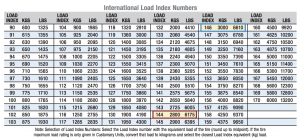We’ve all seen it at one time or another: a vehicle traveling down the road carrying what looks like a dangerously heavy load. Maybe it’s a tractor-trailer carrying rolls of steel, or a pick-up truck loaded down so much the rear bumper is almost dragging the ground. Thanks to load carrying index codes posted on the sidewall of all tires, anyone can calculate the maximum weight their vehicle’s tires can safely manage.
Load Carrying Index
For instance, one tire option for a 2014 Ford F-150 4 Door SuperCab Pick-up is 245/70R17-108T. The last set of numbers in that sequence, 108T, is the load carrying index (108) and the speed rating (T). A tire load rating of 108 means each tire has a load capacity of 2,205 pounds. Multiplied by 4, the truck has a total load capacity based on the rating of the tires, including passengers, of 8,820 pounds. *Note: See GVWR and Payload Capacity below.
As a comparison, one tire option for a 2017 Nissan Altima is 215/60R/16-94T. “94” is the load carrying index, and is equal to 1,475 pounds per tire, or 5,900 total weight capacity for the tires.
If you’ve ever wondered just how much weight a tractor-trailer can haul, an example tire size for a tractor-trailer is 295/75R/22.5 with a 144 load index. That means each tire has a maximum load capacity of 6,175 pounds (see chart below). Multiply that by 18 (18 wheeler) and the tires’ load capacity for this particular vehicle is 111,150 pounds. That does not mean this particular vehicle can be loaded down with 111,000 pounds of freight. Each vehicle, including 18 wheelers, have a Gross Vehicle Weight as well as payload capacity.
Gross Vehicle Weight Rating
The GVWR is a weight listed by the vehicle manufacturer that can be defined as the maximum amount a vehicle can weigh. If a truck’s GVWR is listed at 10,000 pounds and the truck weights 6,000 pounds empty, then its payload capacity is 4,000 pounds.
If you’re wondering if your pick-up truck can haul a load of firewood or some other heavy load, you can check both the load rating of your tires, your vehicle’s GVWR, and your vehicle’s payload capacity. An average cord of hardwood weighs more than 2 tons. Unstacked it will take up to 200 cubic feet in space. An 8 ft. pick up truck bed would have to have the wood piled uniformly at 5 feet tall to fit an un-stacked cord. The average pick up truck can only haul 1/2 a cord of firewood at a time.
Based on our example above of a 2014 Ford F-150, the load capacity of the tires would have no problem carrying the weight of a cord of firewood. However, the payload capacity of a 2014 Ford F-150 is a maximum of 1,988 pounds. A ton of firewood weights roughly 4,000 pounds. Conclusion? If you buy a cord of firewood and want to haul it in your 2014 F-150, you would have to make two trips.
Confused yet? The best answer if you have questions about your vehicle’s load capacity is to use common sense. Just because your tires can handle the load doesn’t mean you can load your vehicle with that much weight. A safe bet is to always adhere to your particular vehicle’s payload capacity, and if you have questions about your tires’ ability to carry the load, check your tire’s load index and compare it to the chart above.
Contact Postle Tire Barn
If you have questions about your tires, give Postle Tire Barn a call. Postle Tire Barn is a family owned and operated tire and automotive business located in Tuscaloosa, AL. We’ve been serving the automotive needs of West Alabama for more than 35 years.




Recent Comments